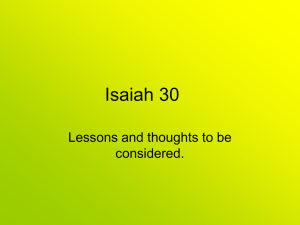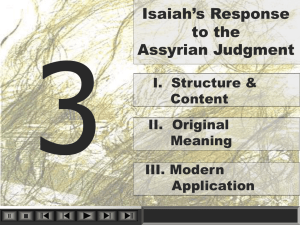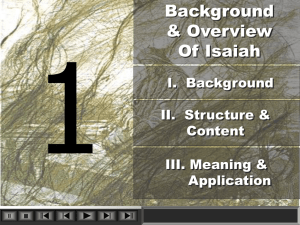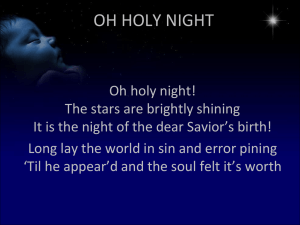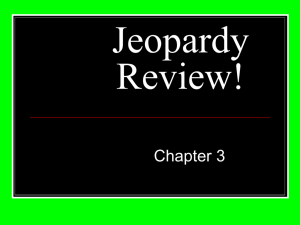The Book of Isaiah - Third Millennium Ministries
advertisement
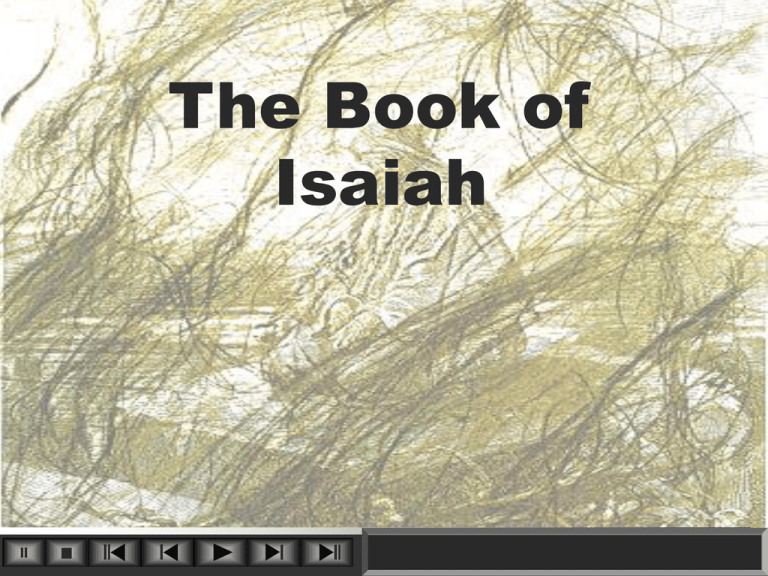
The Book of Isaiah Judgment Leading to Restoration I. Overview II. Original Meaning III. Modern Application Isaiah’s Incredible Scenario of Exile Leading to Restoration (1-6) Isaiah’s Response to the Assyrian Judgment (7-39) Explaining Divine Purposes in Exile Leading to Restoration Establishing Isaiah’s Credibility to Support His Message of Exile Leading to Restoration Isaiah’s Response to the Babylonian Judgment (40-66) Predicting Divine Processes and Israel’s Responsibilities for Restoration Structure/Content of 1:2-6:13 (2.1) Chapter 6 Autobiography (6:1) Death of Uzziah 740 B.C. Closing Out Opening Section Why did Isaiah say these things about Judah and Jerusalem? Both Narrative Chapter 7 Biography (7:1) Coalition Syria-Israel 734 B.C. Beginning New Section What was the historical context of Isaiah’s Ministry during Assyrian judgment? Division Between 6-7 (2.2) Cycles of Judgment Leading to Restoration Justice and Righteousness Modified Lawsuit 1:2-31 That Day Judgment Oracle (2:5-21) Judgment and Restoration Parable of Judgment (5:1-7) Judgment Oracle (2:22-3:15) Judgment Oracle (3:16-4:1) Oracle of Salvation (2:1-4) Oracle of Salvation (4:2-6) Woes (5:8-10) Call Narrative (6:1-13) (“the holy seed” v. 13) Structure/Content of 1:2-6:13 (2.3) Judgment Leading to Restoration I. Overview II. Original Meaning III. Modern Application Lawsuit against Unrighteousness and Injustice in Jerusalem (1:2-31) Setting: After Sennacherib Invasion (8-9) Prosecutor and Judge Yahweh (2) Witnesses Heaven & Earth (2) “reason together” xky Legal Terminology (18; 2:4; 11:4) Defendants Judah/Zion (4,8,21) Summons of Witnesses (2a) Accusations (2b-4) Questioning (5-8) Response (9) Summons of Defendant (10) Accusations (11-14) Sentencing (15) Call to Repentance (16-20) Closing of Case (21-31) Accusation (21-23) Sentencing (24-31) Isaiah, an Observer Themes of Unrighteousness and Injustice jP'v.mi (17) “justice” jP'v.m (21) “righteousness” qd,c, (21) “city of Righteousness” qd,C,h ry[i; (26) “justice” jP'v.miB. (27) “righteousness” hq'd'c.Bi (27) “justice” (Positive Result from Judgment) Structure/Content of 1:2-31 (2.4) Eschatological Vision of Jerusalem Overflowing with Righteousness and Justice (2:1-4) Setting: Before or After Sennacherib Invasion (see Mic 4:1-4) Superscription (1) Supremacy of Jerusalem (2) Recognition of the Nations (3a) Universal Justice from Zion (3b-4) Zion and Universal Justice jpv (2:4) [jP'v.mi (1:17,21,27)] xky (2:4; 1:18) Structure/Content of 2:1-4 (2.5) Judgment on “That Day” (2:5-4:1) Setting: Before or After Sennacherib Invasion (surrounding context: call to people (5) Judgment against Syncretism (5-21) Call to Judah (5) Oracle of Judgment (6-21) Accusation of Syncretism (6-8) Sentencing (9-21) Should v. 5 be included? 2:5-6; 2:22-3:1 Imperatives followed by yKi Judgment against Trusting Human Strength (2:22-3:15) Call to Judah (22) Theme of “that day” Oracle of Judgment (3:1-15) (11, 12,17, 20, 3:7, 18; 4:1) Sentencing (1-12) Accusation Oppression (13-15) hw"hy> ~Ay Judgment against Haughty Women of Zion (16-26) Accusation of Haughtiness (16) Sentencing (3:17-4:1) “Day of the Lord” Structure/Content of 2:5-21 (2.6) hw"hy> ~Ay “Day of the Lord” ANE Background Royal political motif indicating that a worthy king could defeat All of his enemies in a single day. (D. Stuart, “The Sovereign’s Day of Conquest” BASOR 221 [1976] 159-164) In Israel Applied to Israel’s great King, the Lord, to describe his Interventions into history to destroy his enemies and to establish his reign. Blessing for Israel Curses for Israel Isa 13:6,9 Ezk 30:3 Joel 2:31; 3:14 Ob 1:15 Am 5:18 Ezk 13:5 Joel 1:5; 2:1,11 Zeph 1:7,14 Acts 2:20; 1 Co 1:8; 5:5; 2 Cor 1:14; 1 Th 5:2; 2 Th 2:2; 2 Tim 4:8; 2 Pet 3:10; 2 Pet 3:12; Rev 16:14 Day of the Lord (2.7) Salvation on “That Day” (4:2-6) Setting: Before or After Sennacherib Invasion (surrounding context) Adornment of the Survivors (2) Holiness of Zion (3) Cleansing of Zion (4) Protection of Zion (5-6) hw"hy> xm;c “Branch” (11:1-5; 53;2) Jer 23:5; 33:15; Zech 3:8; 6:12; Jhn 15:1ff [J. Baldwin, VT 14 (1964) 93] Women (3:16) arB (65:17,18) Structure/Content of 4:2-6 (2.8) Catastrophic Judgment (5:1-30) Setting: Before or After Sennacherib Invasion (surrounding context) Parable of the Vineyard (1-7) The Parable (1-3) Questioning (4) Sentencing (5-6) Explanation (7) Series of Woes (5:8-24) Woe over Property (8-10) Accusation (8) Sentencing (9-10) Woe over Self-Indulgence (11-17) Accusation (11-12) Sentencing (13-17) Woe over Impatience (18-19) Accusation Woe over Self-Justification (20) Accusation Woe over Arrogance (21) Accusation Woe over Drunken Injustice (22-24) Accusation (22-23) Sentencing (24) Parable as Legal Discourse “Woe!” Funerary Expression Judgment Oracle (25-30) Sentencing (25-30) Structure/Content of 5:1-30 (2.9) Isaiah’s Call (6:1-13) Setting: 740 B.C. (Death of Uzziah) Historical Note (1a) •Isaiah and the Divine Holiness (1b-7) Isaiah and Divine Exaltation(1b-4) God on the Throne (1b) Seraphs Attending (2-4) Isaiah and Divine Forgiveness (5-7) Isaiah’s Confession (5) Divine Response (6-7) •Isaiah and the Divine Call (8-13) Isaiah and Divine Desire (8-10) Divine Desire (8a) Isaiah’s Response (8b) Isaiah and Divine Commission (9-13) Divine Instruction (9-10) Isaiah’s Response (11a) Divine Explanation (11b-13) Divine Holiness (33 times in Isaiah, 26 elsewhere) vAdq' vAdq' vAdq Metaphysical, Moral “clean” / ”unclean” rAhj' rAhj' al “for us” (v. 8) Divine Counsel (Gen 1:26; 11:7) Compare 40:6 Structure/Content of 6:1-13 (2.10) Spiritual Ignorance (1:3) Despising God (1:4) Violence (1:15) Lawless Rulers (1:23) Idolatry (2:8) Trust in Humans (2:22) Proud & Immodest Women (3:16) Drunkenness (5:22) Rejecting God’s Law (5:24) Sins Of Judah Judah will be Judged and Purified Desolation of Land (1:7) No Answers to Prayer (1:15) Devoured by Sword (1:20; 3:25) Physical Affliction (3:17) Jerusalem Laid Waste (5:5) Exile (5:13) Wicked Will be Destroyed Righteous Remnant will Be saved Purging of Dross (1:25) Repentant are Redeemed (1:27) People Walk with the Lord (2:5) Righteous are Rewarded (3:10) Survivors Purged/Sanctified (4:3-4) Restoration “In the last days” (2:1) After the Exile (Deut 4:30; Hos 3:5) Remnant will Return Concept of Remnant “survivors” (1:9) “remaining” (4:3) Zion will Be Glorious Righteous, Faithful City (1:26) Zion, Chief of Mountains (2:3) Glory Cloud (4:4-5) [Holy Stump (6:13)] Summary of 1-6 (2.11) Judgment Against Judah &Jerusalem I. Overview II. Original Meaning III. Modern Application Lawsuit against Unrighteousness and Injustice in Jerusalem (1:2-31) OM I C C Summons of Witnesses (2a) Accusations (2b-4) Questioning (5-8) Response (9) Summons of Defendant (10) Accusations (11-14) Sentencing (15) Call to Repentance (16-20) Closing of Case (21-31) Accusation (21-23) Sentencing (24-31) Application of 1:2-31 (2.12) Eschatological Vision (2:1-4) OM I C C Superscription (1) Supremacy of Jerusalem (2) Recognition of the Nations (3a) Universal Justice from Zion (3b-4) Application of 2:1-4 (2.13) Judgment on “That Day” (4:2-6) OM I C C Judgment against Syncretism (5-21) Call to Judah (5) Oracle of Judgment (6-21) Accusation of Syncretism (6-8) Sentencing (9-21) Judgment against Trusting Human Strength (2:22-3:15) Call to Judah (22) Oracle of Judgment (3:1-15) Sentencing (1-12) Accusation Oppression (13-15) Judgment against Haughty Women of Zion (16-26) Accusation of Haughtiness (16) Sentencing (3:17-4:1) Application of 4:2-6 (2.14) Salvation on “That Day” (4:2-6) OM I C C Adornment of the Survivors (2) Holiness of Zion (3) Cleansing of Zion (4) Protection of Zion (5-6) Application of 2:5-21 (2.15) Catastrophic Judgment (5:1-30) OM I C C Parable of the Vineyard (1-7) The Parable (1-3) Questioning (4) Sentencing (5-6) Explanation (7) Series of Woes (5:8-24) Woe over Property (8-10) Accusation (8) Sentencing (9-10) Woe over Self-Indulgence (11-17) Accusation (11-12) Sentencing (13-17) Woe over Impatience (18-19) Accusation Woe over Self-Justification (20) Accusation Woe over Arrogance (21) Accusation Woe over Drunken Injustice (22-24) Accusation (22-23) Sentencing (24) Judgment Oracle (25-30) Sentencing (25-30) Application of 5:1-30 (2.16) Isaiah’s Call (6:1-13) OM I C C Historical Note (1a) •Isaiah and the Divine Holiness (1b-7) Isaiah and Divine Exaltation(1b-4) God on the Throne (1b) Seraphs Attending (2-4) Isaiah and Divine Forgiveness (1b-7) Isaiah’s Confession (5) Divine Response (6-7) •Isaiah and the Divine Call (8-13) Isaiah and Divine Desire (8-10) Divine Desire (8a) Isaiah’s Response (8b) Isaiah and Divine Commission (9-13) Divine Instruction (9-10) Isaiah’s Response (11a) Divine Explanation (11b-13) Application of 6:1-13 (2.17)
